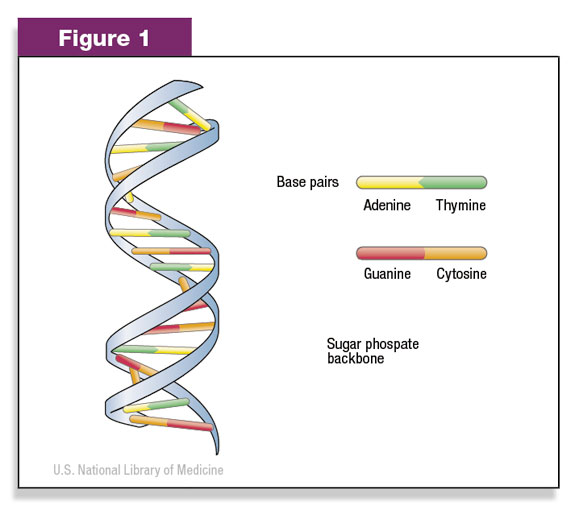After a six-year endeavor, the Bovine Genome Project was completed in 2009 through the efforts of over 300 scientists from 25 countries. A female Hereford cow served as the genetic source for the project, and her genome was compared with that of other cattle breeds. The researchers determined that the bovine genome consists of three billion base pairs and 22,000 genes.

So what does this mean? Well, DNA contains the genetic code in cells, and the genetic code is determined by the sequence of four nucleobases: adenine (A), cytosine (C), guanine (G), and thymine (T). In the DNA molecule, two strands of nucleobases form, and these strands are bound together to form the helical structure of DNA, illustrated in the diagram below. Bond formation between strands is such that A only binds to T, and C only binds to G. An AT and CG bond are termed a “base pair” (see Figure 1).
A gene is a region within the DNA strand that corresponds to a unit of inheritance. The gene is why you can select for certain traits within your herd and have those traits expressed in subsequent generations.
In the bovine, we now know that there are 22,000 places within the genome that determine a cow’s genetic make-up. I know it’s a little confusing, but I hope I haven’t lost you yet, because it gets way more exciting.
So why should we care about the bovine genome project?
Once the complete genomic sequence of a species is determined, researchers can identify differences in individual sequences among animals within a species. These differences allow for identification of genetic sequences that code for increased milk production, improved reproductive performance, improved feed efficiency, etc. Identification of the genetic sequences that provide for these traits can eventually be used to guide breeding programs. This application is still years away, but the possibility now exists.
Are there applications of the bovine genome project beyond agriculture? Yes. Lemay et al. reported on implications of the bovine genome for human nutrition and research. The authors indicated that comparative genomics of the bovine genome will allow for identification of milk- and lactation-related genes across all mammalian genomes that have been sequenced. Studying the evolution of milk synthesis across species can provide information about nutrition because milk is the only food that has uniquely evolved to specifically nourish the mammal it’s intended to feed.
Because milk is synthesized to meet the nutrient requirements of the infant at the expense of the mother, individuals within a species that produce more nourishing milk are more likely to have offspring that survive and thrive. Therefore, those genes are passed along generation after generation. Milk also has nutritional functions beyond providing the infant with nutrients. Lemay et al. identified five unifying nutritional functions of milk:
- Supplies all of the essential nutrients for the growing infant.
- Provides a mixture of biomolecules in complex structures.
- Provides protective molecules to fight off harmful organisms and guide the development of the immune system.
- Contains indigestible complex sugars that promote a subset of protective bacteria in the infant’s gut.
- Contains components that regulate infant development.
With the knowledge obtained from the bovine genome project, not only can we enhance agricultural practices, but we can improve our understanding of human nutrition and the role of milk in the evolution of a species. Something to ponder the next time you’re milking your cows. PD
Reference omitted due to space but are available upon request by sending an email to editor@progressivedairy.com.
—Excerpts from The William H. Miner Agricultural Research Institute Farm Report, March 2010
Sarah Boucher is with the William H. Miner Research Institue. Email Sarah Boucher.






